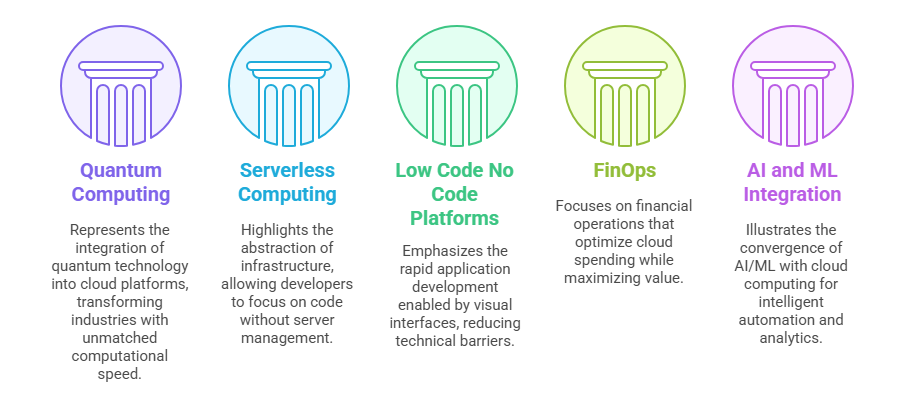As 2025 is underway, cloud computing trends continues to evolve, driving innovation across industries. The cloud remains a crucial infrastructure for businesses, offering scalable, flexible solutions that boost efficiency, lower costs, and accelerate technological advancements. Gartner predicts that by 2026, 75% of organizations will adopt a digital transformation strategy built around cloud technology as its core foundation.
While cloud infrastructure and platform services are experiencing the fastest growth in spending, the Software as a Service (SaaS) segment continues to be the largest in terms of end-user spending. In this blog, we’ll explore the top 5 cloud computing trends of 2025, highlighting key shifts shaping the future of data storage, processing, and management. Also, we discuss in brief about why Microsoft Azure is future of cloud computing.
Top 5 Cloud Computing Trends

1. Quantum Computing: Future of Cloud Computing
-
- Quantum computing is leading the charge in emerging cloud technologies, set to transform industries by solving complex problems at unmatched speeds. Unlike conventional systems, quantum computing uses qubits to perform calculations that go beyond the capabilities of classical computers.
- Its integration into cloud platforms brings immense potential, reshaping how businesses utilize cloud services for innovation and operational efficiency.
- As part of the latest advancements in cloud technology, major players such as Amazon Bracket, IBM Quantum, and Google Quantum AI are incorporating quantum computing into their offerings.
- These platforms provide practical examples of cloud technology in areas like cryptography, drug discovery, and financial modeling.
- The expanding range of cloud-based applications powered by quantum computing offers businesses tools to tackle optimization problems, simulate molecular interactions, and enhance artificial intelligence capabilities.
2. Serverless Computing
Serverless computing abstracts the underlying infrastructure, allowing developers to focus solely on writing and deploying code without worrying about server management. This trend will continue to gain momentum in 2025 as more businesses realize the benefits of reduced operational complexity, improved scalability, and cost optimization offered by serverless architectures.
-
- Reduced Operational Complexity: Serverless computing abstracts away the underlying infrastructure and eliminates the need for developers to manage servers. This abstraction allows developers to focus solely on writing code and building applications without worrying about server provisioning, scaling, or maintenance.
- Cost Optimization: Serverless computing offers cost advantages by charging businesses only for the actual usage of resources, rather than a fixed allocation. Traditional server-based architectures often involve overprovisioning to accommodate peak loads, leading to underutilized resources during periods of lower demand.
3. Low Code No Code Platform
-
- Low-code and no-code platforms have become essential in the advancement of emerging technologies within cloud computing, enabling businesses to build applications more quickly with minimal technical expertise. These platforms are now a core part of the cloud technology landscape, allowing users to create applications through visual interfaces instead of relying on traditional coding methods.
- By utilizing these tools, companies can streamline workflows, improve productivity, and reduce development costs, positioning themselves as leaders in the evolving cloud services space.
- As part of the array of cloud-based applications, low-code and no-code platforms such as Microsoft PowerApps, OutSystems, and Mendix empower organizations to drive rapid innovation. These platforms are prime examples of cloud technologies, enabling teams to easily automate processes, develop customer-facing applications, and implement AI-driven solutions.
- As they highlight the top cloud technologies, low-code and no-code solutions offer a seamless way to integrate cloud services with business objectives, providing both scalability and flexibility.
4. FinOps: Future Application of Cloud Computing
-
- FinOps, short for Financial Operations, is transforming how organizations manage costs in emerging cloud computing technologies. This approach emphasizes collaboration across teams to manage cloud spending effectively, making it a crucial element in the cloud technology landscape.
- By adopting FinOps, organizations gain enhanced visibility and control over their cloud services, ensuring they optimize costs while maximizing value in line with the latest cloud technology developments.
- As a key part of leading cloud technologies, FinOps is becoming essential for managing the various cloud-based applications that power modern businesses. Cloud-native tools like AWS Cost Explorer, Google Cloud’s Billing Reports, and Microsoft Azure Cost Management exemplify cloud technologies that help organizations track, predict, and allocate cloud costs efficiently. These tools emphasize the need to align financial responsibility with technical performance across teams.
- Incorporating FinOps into emerging cloud strategies enables organizations to maintain financial discipline while scaling cloud operations.
- By embracing this practice, businesses can balance agility with cost optimization, ensuring their cloud investments yield measurable returns. With FinOps at the forefront, companies can confidently navigate digital transformation trends and ensure a sustainable future in the cloud.
5. Artificial Intelligence (AI) and Machine Learning (ML) Integration
The convergence of cloud computing and AI/ML technologies is set to revolutionize various industries. Cloud platforms provide the necessary infrastructure and resources to train and deploy AI/ML models at a scale. In 2025, we can expect increased integration of AI and ML capabilities into cloud services, enabling businesses to unlock the power of intelligent automation, predictive analytics, and personalized experiences.
-
- Azure Machine Learning: Azure Machine Learning is a cloud-based platform that enables data scientists and developers to build, deploy, and manage ML models at scale. It provides a comprehensive set of tools and services for training, testing, and deploying ML models. Azure Machine Learning allows organizations to leverage pre-built ML models, build custom models using popular frameworks like TensorFlow and PyTorch, and automate ML model deployment pipelines.
- Azure Cognitive Services: Azure Cognitive Services offers a range of pre-trained AI models and APIs that allow developers to easily integrate AI capabilities into their applications. These services include vision, speech, language, and decision APIs, providing functionalities such as image recognition, speech recognition, natural language understanding, and personalization. Azure Cognitive Services enables organizations to add advanced AI features to their applications without the need for extensive ML expertise.
- Azure Databricks: Azure Databricks is a collaborative Apache Spark-based analytics platform that integrates with Azure to provide scalable data processing and ML capabilities. It allows data scientists and engineers to collaborate on building ML models using notebooks and leverages distributed computing to process large volumes of data efficiently. Azure Databricks simplifies the process of building ML pipelines, from data preparation and feature engineering to model training and deployment.
Microsoft Azure: Future of Cloud Computing
Azure Cloud Computing stands as a compelling choice, offering a robust and scalable platform for diverse business needs. Its comprehensive suite of services, from virtual machines to AI-driven solutions, empowers organizations to innovate and adapt swiftly. Azure’s global infrastructure ensures high availability and performance, while its commitment to security and compliance provides peace of mind. Seamless integration with existing Microsoft technologies simplifies migration, and its pay-as-you-go model optimizes costs. Whether you’re a startup or an enterprise, Azure’s flexibility and innovation make it a strategic partner for driving digital transformation.
Contact us for FREE Azure POC.
Conclusion
As we look ahead to the future of cloud computing trends in 2025, these emerging trends hold tremendous potential to shape the way businesses leverage technology. Edge computing, multi-cloud strategies, serverless computing, AI/ML integration, and enhanced data security are set to drive innovation, improve efficiency, and empower organizations to achieve their digital transformation goals. By staying informed and embracing these trends, businesses can position themselves for success in the ever-evolving cloud computing landscape.
FAQs
It allows mobile devices, such as smartphones and tablets, to offload resource-demanding tasks, data storage, and processing to cloud servers, helping to overcome limitations like limited computing power, storage space, and battery life.
Gartner predicts that by 2027, cloud computing will play a pivotal role in driving business innovation and will become the dominant form of computing. The outlook for cloud computing is promising, with many companies transitioning to cloud-based infrastructure due to its adaptability, scalability, advanced data analytics, and continuous innovation.
The demand for cloud computing is continuing to rise in 2025. A study by 31west.net has projected that the market will reach a value of $864 billion this year. Additionally, LinkedIn forecasts that the cloud computing industry will grow at a compound annual growth rate (CAGR) of 18% from 2020 to 2025, reflecting the strong and ongoing demand for cloud services.
Cloud computing offers a highly secure environment, often surpassing the security of traditional on-premises systems. Cloud service providers deliver a range of security features, daily backup options, and advanced data management solutions to ensure the safety of all data stored on the cloud.
Planning to migrate your critical data on Azure Cloud? Book a FREE consultation!










